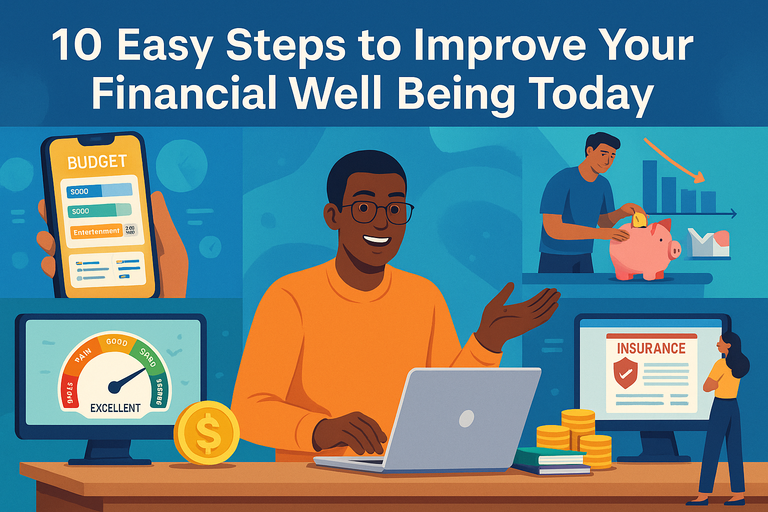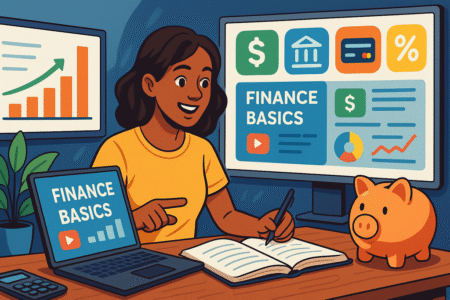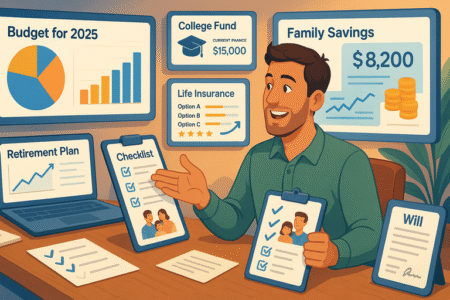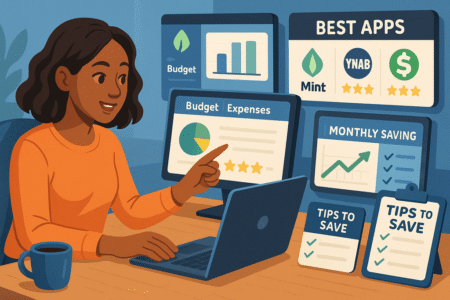Table of Contents
Improving your financial well being doesn’t have to feel overwhelming or complicated. What if you could take small, practical steps today that set you up for lasting security and peace of mind? Many people wonder where to even start—should you focus on saving, paying off debt, or investing?
This guide will walk you through 10 clear and doable steps that can help you take control of your money, reduce stress, and build confidence in your financial future.
1. Create A Realistic Monthly Budget That Works
A budget isn’t about restricting joy — it’s about giving yourself permission to spend on what truly matters while avoiding those sneaky money leaks.
A solid monthly budget keeps you in control instead of letting your bank account surprise you at the end of every month.
Track Every Expense For At Least 30 Days
The first step is awareness. For 30 days, write down every dollar you spend. Yes, every coffee, every snack, every late-night online purchase. It may feel tedious at first, but it’s like turning on a light in a dark room — suddenly, you see exactly where your money is slipping away.
Here’s how I usually recommend doing it:
- Use your phone’s Notes app if you prefer something simple.
- Or download your bank statements and categorize line by line.
- If you want automation, apps like Mint or YNAB (You Need A Budget) do this instantly.
The goal is not to judge yourself but to spot patterns. That $8 streaming subscription you forgot about? Or those “quick” grocery runs that add up to hundreds? Tracking exposes reality — and once you see it, you can adjust it.
Separate Essential Spending From Lifestyle Choices
Once you’ve got the raw data, split it into two clear categories: essentials and lifestyle. Essentials are things like rent, groceries, utilities, and transportation — the non-negotiables that keep life running. Lifestyle covers the “wants”: dining out, Netflix, travel, shopping.
Here’s a quick mental trick I use: If losing it tomorrow would put your health, home, or job at risk, it’s essential. Everything else is lifestyle.
This exercise often brings “aha” moments. For example, I realized I was spending more on takeout than groceries in one month — not wrong, but definitely not aligned with my long-term financial well being.
Use Budgeting Apps To Stay Organized And Accountable
After you’ve categorized, a budgeting app can do the heavy lifting.
YNAB helps you “give every dollar a job,” which forces you to prioritize spending.
Mint automatically syncs with your accounts and shows where you’re over budget.
PocketGuard is great if you just want to know how much is “safe to spend” at any moment.
The magic of apps isn’t the tech itself, but the accountability. They send you alerts, track your habits, and give you a dashboard that feels like a personal money coach.
I like that I can open my app at the store and know instantly if I should be buying the new gadget or waiting until next month.
Pro tip: Choose one tool and stick with it. Switching apps constantly often means avoiding facing the numbers.
2. Build A Starter Emergency Fund Quickly
Think of an emergency fund as your personal shock absorber. Life throws curveballs — medical bills, car repairs, job changes — and without a buffer, you’re forced to lean on credit cards or loans.
Even a small emergency fund can dramatically lower stress and protect your financial well being.
Aim For At Least $1,000 As An Initial Safety Net
The “$1,000 rule” is simple but powerful. It’s not meant to cover everything, but it’s enough to handle the most common emergencies: a flat tire, a plumbing issue, or replacing a broken phone.
Starting here keeps you motivated because it feels achievable, not overwhelming like saving six months of expenses right away.
Here’s how to get there faster:
- Sell unused items around your house (electronics, clothes, furniture).
- Redirect tax refunds, bonuses, or side hustle money into this fund.
- Cut non-essential spending for one month and funnel the difference.
I once challenged myself to do a “no-spend January.” I cut out takeout and subscriptions, and by the end of the month, I had my first $500 emergency stash. That psychological win gave me momentum to keep going.
Automate Savings Transfers To Remove Temptation
Relying on willpower doesn’t work. Automation does. Set up a recurring transfer from your checking account to savings right after payday. Even $25 per week grows to $1,300 in a year without you lifting a finger.
Most banks let you set up these transfers in minutes:
- Log into your online banking dashboard.
- Select Transfers > Set Up Recurring Transfer.
- Choose the amount, frequency, and savings account destination.
It’s the same principle as a gym membership — if the money is gone before you see it, you adjust naturally. I believe automation is the single best hack for people who “forget” to save.
Keep Your Emergency Fund Separate From Spending Accounts
Your emergency fund should not be mixed into your everyday checking account. Out of sight, out of mind. If you see that extra $500 sitting there, it’s too tempting to “borrow” for something non-emergency.
I suggest opening a high-yield savings account with no debit card attached. These accounts often give you 3–4% interest, which means your money quietly grows while it waits.
When I moved my emergency savings into a separate online account, I stopped dipping into it — because it was just enough friction to keep me disciplined.
Pro tip: Label the account “Emergency Fund Only” so every time you see it, you remember its purpose.
3. Pay Off High-Interest Debt First
High-interest debt is like trying to run uphill with a backpack full of bricks. No matter how much you save or invest, the weight of double-digit interest will drag you down.
Tackling this first is the fastest way to free up money for your financial well being.
Focus On Credit Cards And Payday Loans To Save Money
Credit cards and payday loans are usually the most toxic because of their sky-high interest rates.
The average credit card interest rate hovers around 20 percent — that means a $1,000 balance could cost you $200 a year in interest if you only make minimum payments.
Payday loans? They can top 300 percent APR, which is basically financial quicksand.
Here’s a simple way to start:
- Write down every debt you owe, the balance, the minimum payment, and the interest rate.
- Sort them by highest interest rate at the top.
- Prioritize sending extra money toward those while paying the minimum on everything else.
I once had a client who discovered that two of their small payday loans were eating more in monthly interest than their car payment. Closing those out first saved them nearly $250 a month — money they could then redirect to bigger goals.
Use The Avalanche Method For Maximum Interest Savings
The avalanche method is one of the smartest debt payoff strategies. Here’s how it works:
- Keep paying the minimum on all debts.
- Throw any extra money you have at the debt with the highest interest rate.
- Once that’s gone, roll the payment into the next highest-interest debt.
It’s like a snowball rolling downhill, but instead of focusing on emotional wins (like the smallest balance), you’re crushing the ones costing you the most money first.
For example: If you have a $5,000 credit card at 22 percent and a $2,000 car loan at 6 percent, the avalanche tells you to go hard on the credit card. The math works in your favor — you’ll save hundreds or even thousands over time.
I advise writing this out on paper or in a spreadsheet. Watching balances fall one by one makes the progress real and motivating.
Negotiate Lower Interest Rates With Lenders
Most people don’t realize this, but you can actually call credit card companies and ask for a lower rate. I’ve done this myself, and sometimes all it takes is saying, “I’ve been a loyal customer for years, but I’m struggling with the current rate. Can you reduce it?”
Practical steps:
- Call the customer service line on the back of your card.
- Be polite, explain your situation, and ask for a reduced APR.
- If they say no, ask to speak with a supervisor.
Even a small drop from 22 percent to 16 percent could save you hundreds a year. If the lender refuses, consider transferring your balance to a 0% introductory APR card. Just be sure you understand the transfer fees and pay it off before the promo period ends.
4. Set Clear And Motivating Financial Goals
Without goals, money slips through your fingers. Setting financial goals gives you a destination, a reason to say no to impulse buys, and something to celebrate along the way. It’s the “why” behind your budgeting and debt payoff.
Define Short-Term And Long-Term Money Milestones
Short-term goals are things you can achieve in the next 6–12 months, like saving $1,000, paying off a credit card, or building a vacation fund. Long-term goals stretch further — think buying a home, retiring comfortably, or sending kids to college.
I believe in writing these down in plain, simple language. For example:
- Short-term: “Save $500 by June for car repairs.”
- Long-term: “Invest $300 a month for retirement starting this year.”
By separating the two, you prevent frustration. You won’t feel like a failure for not buying a house this year when your real focus is just building that starter emergency fund.
Write Down Goals And Review Them Monthly
There’s something powerful about seeing your goals in writing. I suggest using a notebook, a whiteboard in your kitchen, or even the notes app on your phone. The key is to review them regularly.
Every month, ask yourself:
- Am I moving closer to this goal?
- Do I need to adjust the timeline?
- Is this goal still important to me?
One of my personal habits is a “money check-in” on the first Sunday of every month.
I make coffee, pull up my budget app, and see how I’m tracking against my written goals. That ritual has kept me consistent even when life got chaotic.
Break Large Goals Into Smaller, Achievable Steps
Big goals can feel overwhelming. “Save $50,000 for a down payment” sounds impossible — but “Save $200 a month” feels doable. Breaking large goals into bite-sized pieces keeps you motivated because you hit wins along the way.
For example:
- Goal: Save $10,000 for a wedding in two years.
- Breakdown: That’s $417 a month. If that feels tight, maybe cut it to $300 and extend the timeline.
I like to think of it like hiking a mountain: if you only stare at the summit, it feels endless. But if you focus on reaching the next marker, step by step, suddenly the summit doesn’t seem so far.
Pro tip: Celebrate milestones. Every time you hit 25%, 50%, or 75% of a goal, reward yourself with something small — a nice dinner, a fun activity. Progress deserves recognition.
5. Track Your Net Worth To Measure Progress
Your net worth is like a financial report card. It’s not about bragging rights — it’s about seeing where you stand today and whether you’re moving forward or slipping backward.
Tracking it helps you measure your financial well being in a way a budget alone can’t.
Calculate Assets And Liabilities To See The Full Picture
Net worth is simple math:
Net Worth = Assets – Liabilities
Assets include:
- Cash in checking and savings
- Investments like 401(k), IRAs, or brokerage accounts
- Home equity (market value minus mortgage balance)
- Cars, if they still hold value
Liabilities include:
- Credit card balances
- Student loans
- Auto loans
- Mortgage balance
When I first calculated my net worth, I was shocked — not because it was high, but because it was negative. But that clarity was powerful.
Once you see the number, you can set a direction. Even if it’s -$10,000, you know the path is to move toward zero and eventually positive growth.
Update Net Worth Quarterly To Stay Motivated
Checking net worth daily is like stepping on a scale every hour — frustrating and meaningless. Instead, update it quarterly. This way, you can see actual trends without obsessing over market swings.
For example, if you pay off a $2,000 credit card and grow your 401(k) by $3,000, your net worth just improved by $5,000 in three months. That’s real momentum, and it keeps you motivated to continue.
I personally do this at the end of March, June, September, and December. It feels like a quarterly progress report, and the ritual keeps me accountable without becoming overwhelming.
Use Simple Tools Or Spreadsheets For Clarity
You don’t need fancy software. A simple Excel or Google Sheet can track net worth beautifully. List your accounts down the left, balances in the middle, and totals at the bottom. Then subtract liabilities from assets.
If you prefer apps, Personal Capital (now Empower) is great because it automatically pulls balances from your accounts into one dashboard. I like it because the graph shows how your net worth changes month by month.
Pro tip: Make your spreadsheet visual. A simple line chart of your net worth climbing (even slowly) is motivating in a way raw numbers aren’t.
6. Cut Unnecessary Subscriptions And Hidden Expenses
Subscriptions are like weeds in a garden — they creep in quietly and before you know it, they’re everywhere. Cutting them out can free up cash every single month without feeling like a sacrifice.
Review Bank Statements To Identify Unused Services
Start by printing out your last two months of bank and credit card statements. Highlight every recurring charge — Netflix, gym, software, streaming, meal kits. Many of us have services we forgot about or barely use.
When I did this, I found an audiobook subscription quietly charging me $15 a month even though I hadn’t downloaded a book in over a year. That’s $180 wasted.
Just scanning through your accounts once often reveals at least one or two “leaks” you can fix instantly.
Cancel Or Downgrade Memberships You Rarely Use
Not every subscription has to go, but many can be trimmed. If you only visit the gym twice a month, maybe a pay-per-visit plan is smarter. If you’re paying for three streaming platforms but mostly watch one, cut the others.
Here’s a simple script you can use: “I need to cancel my subscription as I’m not using it enough right now.” Most companies make it harder than it should be, but persistence saves you money.
Pro tip: If you like the service but hate the price, try downgrading. Many platforms offer cheaper, ad-supported plans or family-sharing options.
Replace Costly Habits With Cheaper Alternatives
Sometimes cutting subscriptions feels painful — like giving up your favorite shows or convenience. Instead of removing joy, think of substitutions.
- Swap a $12 Spotify Premium plan for free Spotify with ads.
- Replace a $60 meal kit with a $20 grocery store meal plan app.
- Trade the $40-a-month coffee shop habit for brewing at home and treating yourself once a week.
These swaps still give you enjoyment but at a fraction of the cost. I found that cutting one $50 subscription gave me enough breathing room to increase my emergency fund savings by 20 percent each month.
7. Boost Your Income With Side Hustles Or Skills
Cutting expenses only takes you so far. To truly grow your financial well being, increasing income is key. Even a few hundred extra dollars a month can accelerate debt payoff, savings, and investing.
Leverage Freelance Platforms For Extra Work
Freelance platforms like Upwork, Fiverr, and Freelancer let you earn money with skills you already have. Writing, graphic design, social media management, data entry — all of these can bring in consistent side cash.
For example, on Upwork, you can go to “Find Work > Submit a Proposal” and pitch directly to clients looking for short projects. I know someone who started proofreading for $20 an hour on weekends and turned it into an extra $500 a month.
The best part? You set your hours. It’s flexible, and you can scale it up or down depending on your goals.
Turn Hobbies Into Income-Generating Opportunities
Hobbies can do more than relax you — they can pay. Love photography? Sell stock photos online. Enjoy crafting? Open an Etsy shop. Play video games? Streaming platforms like Twitch or YouTube can generate income through ads and donations.
One of my friends turned their weekend baking hobby into a small local business. They started selling to neighbors, then scaled to farmers’ markets. What started as fun now pays part of their rent.
The point is: Don’t dismiss hobbies as “just for fun.” Sometimes, they hold hidden earning power.
Invest In Learning New Skills That Increase Earning Power
Sometimes the smartest way to boost income isn’t a side hustle — it’s making yourself more valuable in your day job. Investing in new skills, like coding, project management, or public speaking, can open doors to promotions and higher-paying roles.
I suggest checking low-cost platforms like Coursera, LinkedIn Learning, or Udemy. Many of these courses are under $50 but can unlock thousands in future salary growth.
Think of it this way: spending $100 on a certification that helps you land a $5,000 raise is an incredible return on investment. That’s better than any stock market average.
Pro tip: Don’t wait for your employer to tell you what skills to learn. Be proactive and build the ones you know will make you harder to replace.
8. Start Investing With Small, Consistent Contributions
Investing is one of the most powerful ways to build long-term financial well being. The key isn’t timing the market perfectly — it’s starting small, staying consistent, and letting time do the heavy lifting.
Open A Low-Cost Index Fund Or Robo-Advisor Account
If you’ve never invested before, the simplest place to start is with a low-cost index fund or a robo-advisor.
- Index funds (like Vanguard’s Total Stock Market Index) spread your money across thousands of companies, lowering your risk.
- Robo-advisors like Betterment or Wealthfront handle everything automatically — from choosing investments to rebalancing your portfolio.
Opening one of these accounts usually takes less than 20 minutes. From the website or app, you’ll click “Open an Account,” answer a few questions about your goals and risk tolerance, and connect your bank for transfers.
I recommend this path because it removes the guesswork. You don’t have to pick individual stocks or obsess over market news.
Commit To Regular Contributions, No Matter How Small
Consistency beats size. Even $25 a week can snowball into something huge over time. The magic comes from compound growth — your money earns returns, and those returns start earning returns of their own.
Here’s a simple setup:
- Log into your investment account.
- Go to “Funding” or “Transfers.”
- Set an automatic weekly or monthly transfer.
Think of it like a subscription to your future. Instead of Netflix taking $15 every month, you’re paying yourself.
Focus On Long-Term Growth Instead Of Timing The Market
Trying to buy at the “perfect” moment usually backfires. The market goes up and down, and nobody gets it right all the time. What works is staying invested for the long haul.
For example, if you had invested $10,000 in the S&P 500 in 1990 and left it alone, it would have grown to over $200,000 by 2020 — even with recessions, crashes, and downturns along the way.
I always remind myself: the best time to plant a tree was 20 years ago. The second-best time is today.
9. Improve Your Credit Score For Future Savings
Your credit score isn’t just a number. It decides how much you’ll pay in interest on loans, whether you qualify for the best mortgage rates, and sometimes even if you land a new apartment.
Improving it is one of the smartest ways to boost your financial well being.
Pay Bills On Time To Build Positive Credit History
Payment history makes up about 35 percent of your credit score, so this is the single biggest factor. Even one late payment can drop your score by 50 to 100 points.
I suggest setting up autopay for every recurring bill — credit cards, utilities, loans. Log into your account, go to “Payments,” and click “Set Up AutoPay.”
Even if you only schedule the minimum payment, it prevents missed deadlines and protects your score.
Keep Credit Utilization Below 30 Percent
Credit utilization means how much of your available credit you’re using. If you have a $5,000 limit and carry a $3,000 balance, that’s 60 percent utilization — too high. The goal is under 30 percent, and under 10 percent is even better.
Here are two quick fixes:
- Pay balances down before the statement date, not just before the due date.
- Ask for a credit limit increase, which lowers your utilization ratio without extra debt.
I once had a $2,000 card balance on a $5,000 limit (40 percent). I called the bank and requested a higher limit. They bumped me to $8,000. Instantly, my utilization dropped to 25 percent, and my score jumped 30 points.
Review Your Credit Report For Errors And Disputes
Mistakes happen. Old accounts may show as open, or payments you made on time might be listed as late. These errors can drag your score down unfairly.
You can request a free credit report annually at AnnualCreditReport.com. Go line by line, and if you spot an error, file a dispute directly with the credit bureau.
It’s worth the time. Fixing one mistake could save you thousands in interest over the life of a loan.
10. Protect Your Financial Future With Insurance And Planning
Building wealth is important, but protecting it matters just as much. Insurance and planning may not feel exciting, but they create a safety net so your progress isn’t wiped out by one unexpected event.
Get Basic Health, Life, And Disability Coverage In Place
Health insurance shields you from medical bills that could bankrupt you. Life insurance provides for loved ones if something happens to you. Disability insurance replaces income if illness or injury prevents you from working.
I recommend starting with employer benefits if available. From your HR dashboard, look under “Benefits” to see options. If coverage feels limited, shop private policies online. A simple term life policy is often cheaper than you think — sometimes less than a streaming subscription.
Create A Simple Will Or Estate Plan For Peace Of Mind
Even if you don’t have significant assets, a will ensures your wishes are followed. Without one, the state decides what happens, which can cause stress for your family.
Basic online tools like LegalZoom or Trust & Will can help you draft a will in under an hour. At minimum, name beneficiaries for your accounts and decide who will handle things if you can’t.
It’s not about wealth. It’s about giving loved ones clarity and peace during tough times.
Revisit Your Financial Plan Yearly To Stay On Track
Life changes. You may get married, have kids, switch jobs, or buy a house. Revisit your plan at least once a year to adjust insurance, update beneficiaries, and confirm your goals still make sense.
I personally do this each January — review insurance, check savings goals, and update my will if needed. It’s like spring cleaning, but for finances.
Pro Tip To Strengthen Financial Well Being
Start where you are, not where you think you should be. Don’t compare your progress to anyone else’s — financial well being is personal. Even small actions, like paying $20 toward debt or transferring $10 into savings, build momentum.
What matters most is consistency. Each step stacks on the last, and over time, those small choices create a life with less stress, more security, and more freedom to enjoy the things you love.






